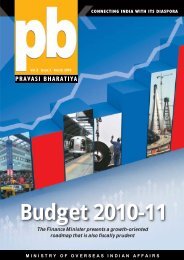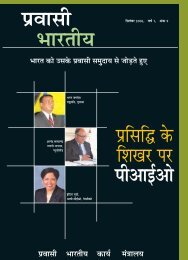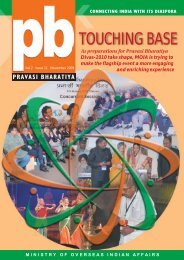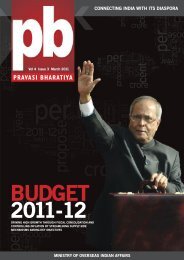annual report1-final.qxd - Overseas Indian
annual report1-final.qxd - Overseas Indian
annual report1-final.qxd - Overseas Indian
You also want an ePaper? Increase the reach of your titles
YUMPU automatically turns print PDFs into web optimized ePapers that Google loves.
Roundtable 2<br />
regulatory framework. !<br />
ROUND TABLE II<br />
INDIA: ECONOMIC POWERHOUSE<br />
Chair:<br />
Speaker:<br />
Suresh Prabhu,<br />
Member of<br />
Parliament<br />
Roopa Purushottam,<br />
Goldman Sachs<br />
Roopa Purushothaman presented the BRIC report,<br />
which focused on a dramatically different global economy.<br />
The objective of the report was to understand<br />
shifts in global spending power and foresaw a 50-year<br />
roadmap of growth and incomes.<br />
It further mentioned that the BRIC economies (Brazil,<br />
Russia, India and China) could be larger than the G6 in<br />
USD terms in less than 40 years while China could<br />
overtake the U.S. as the world’s largest economy in a little<br />
over 30 years. Of the current G6, only the U.S. and<br />
Japan might be among the six largest economies in<br />
2050. She said that new demand from the BRIC<br />
economies could rival the current G6 within a decade<br />
and dwarf it by 2050. However, individuals in BRIC are<br />
still likely to be poorer on average than individuals in<br />
the G6 economies, except in Russia. Therefore, she suggested<br />
that there was a need for some basic conditions.<br />
These were sound and stable macroeconomic policies,<br />
strong political institutions, openness and high levels of<br />
education. India had the most work to do in broadening<br />
education, she reminded.<br />
While looking at the investment scenario,<br />
Purushottam mentioned that in India, trade share was<br />
low but rising in respect to other BRICs. Though the<br />
service sector was growing, it would still not solve the<br />
problem. Even IT share was small. In coming years,<br />
there could be some positive spillovers, but employment<br />
would remain an issue. While comparing China<br />
and India, Purushottam highlighted that there were<br />
many similarities in both the countries like impressive<br />
growth performance over the past decade, massive<br />
labour force potential, strong diasporas to participate in<br />
economic development.<br />
However there were also stark contrasts between the<br />
two — like India focusing on services instead of manufacturing.<br />
There was also the problem of contrasting<br />
political structures as well as different approaches to<br />
investment. India was about 10-15 years behind China<br />
in the process, she said.<br />
She summed up the presentation by saying that<br />
India’s growth rate remained above five percent<br />
throughout the period. India’s GDP would outstrip that<br />
of Japan by 2032. Though India’s income per capita in<br />
2050 would rise to 35 times from the current levels, still<br />
it would be significantly lower than the other countries.<br />
Hence, critical issues for sustainable development are<br />
48
















![flaxkiqj feuh izoklh Hkkjrh; fnol] vDVwcj 9&11 - Overseas Indian](https://img.yumpu.com/43977040/1/184x260/flaxkiqj-feuh-izoklh-hkkjrh-fnol-vdvwcj-911-overseas-indian.jpg?quality=85)
